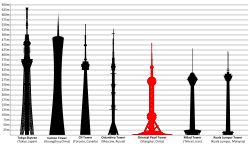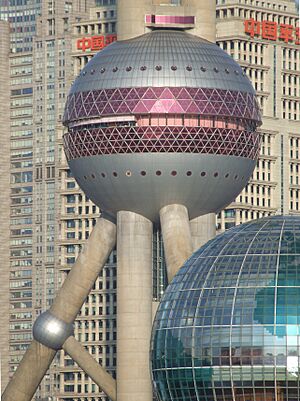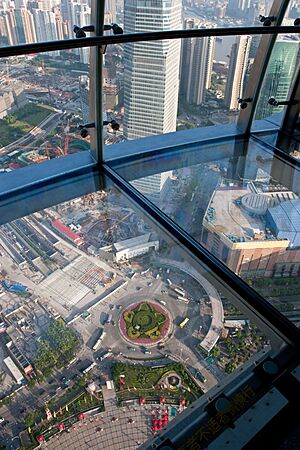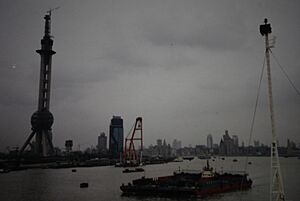Oriental Pearl Tower facts for kids
Quick facts for kids Oriental Pearl Radio & TV Tower |
|
|---|---|
|
东方明珠广播电视塔
|
|

The Oriental Pearl Tower
|
|
| General information | |
| Type | Communication, hotel, observation, restaurant |
| Location | Shanghai |
| Coordinates | 31°14′30.01″N 121°29′40.98″E / 31.2416694°N 121.4947167°E |
| Construction started | July 30, 1991 |
| Completed | November 18, 1994 |
| Opened | May 1, 1995 |
| Height | |
| Antenna spire | 468 m (1,535 ft) |
| Top floor | 351 m (1,152 ft) |
| Technical details | |
| Floor count | Equivalent of a 103 story building |
| Lifts/elevators | 6 |
| Design and construction | |
| Architect | Shanghai Modern Architectural Design Co. Ltd. |
| Developer | Shanghai Oriental Group Co. Ltd. |
The Oriental Pearl Tower is a super cool TV tower in Shanghai, China. It looks like something from the future! This amazing tower was built between 1991 and 1994. For a while, it was the tallest building in China.
The tower is famous for its unique design and its many observation decks. It's a major symbol of Shanghai and a top place for tourists to visit.
Contents
Tower Design
The Oriental Pearl Tower stands really tall, reaching about 468 meters (1,535 feet) high. This includes its antenna at the very top. From 1994 to 2007, it was the tallest freestanding building in China and all of Asia!
Strong Base
The tower is located in Lujiazui, right by the Huangpu River. Because the ground there is quite soft, engineers had to build a super strong base. They put large concrete pillars deep into the earth. Steel pipes and plates were also used to give it extra support. This clever building method helped make sure the tower stood firm.
Cool Spheres
The tower has three big, round platforms that look like giant pearls. These "pearls" are connected by three pillars and an elevator in the middle. The designers said the tower's look was inspired by an old Chinese poem called "Pipa xing." The spheres are made with a strong steel frame and covered with concrete tiles and red glass.
Fun Observation Decks
There are fifteen different levels where you can look out and see the city. On the lower levels, you can find fun things like a revolving restaurant that slowly spins, an indoor roller coaster, and museums. Some of the highest levels even have amazing glass floors! Imagine looking straight down from so high up! There's also a hotel called the Space Hotel between two of the big spheres.
Tower History
How it Started
The idea for a new TV tower in Shanghai first came up in 1983. People wanted to improve TV and radio broadcasts. They planned for the tower to be about 400 meters (1,312 feet) tall.
In 1984, the city leaders officially approved the idea. They chose a spot in Lujiazui, an area that was growing very fast. Later, in 1986, the plan was updated to make the tower even taller, reaching 468 meters (1,535 feet). Many different designs were looked at, and the "Oriental Pearl" design was chosen in 1988.
Building and Opening
Construction on the tower began on July 30, 1991. It was a huge project! By December 1993, the main body of the tower was finished. The antenna was put on top in May 1994. All the inside parts were ready by October 1994, marking the end of construction.
The Oriental Pearl Tower officially opened to the public in May 1995. It started broadcasting five TV channels and radio programs.
Its Importance

Awards and Visitors
The Oriental Pearl Tower quickly became very popular. In 1995 and 1996, many important leaders from other countries came to visit it. The tower has won several awards and is listed as one of China's top tourist attractions. It's truly one of the "Top Ten New Landmarks in Shanghai."
A Shanghai Icon
Since it opened, the Oriental Pearl Tower has been a famous symbol of Shanghai. You can see it in many pictures and videos about the city. Millions of tourists visit it every year to enjoy its amazing views and unique design.
See also
 In Spanish: Torre Perla Oriental para niños
In Spanish: Torre Perla Oriental para niños
- List of tallest buildings in Shanghai
- List of tallest freestanding structures in the world
- List of the world's tallest structures
- List of towers




